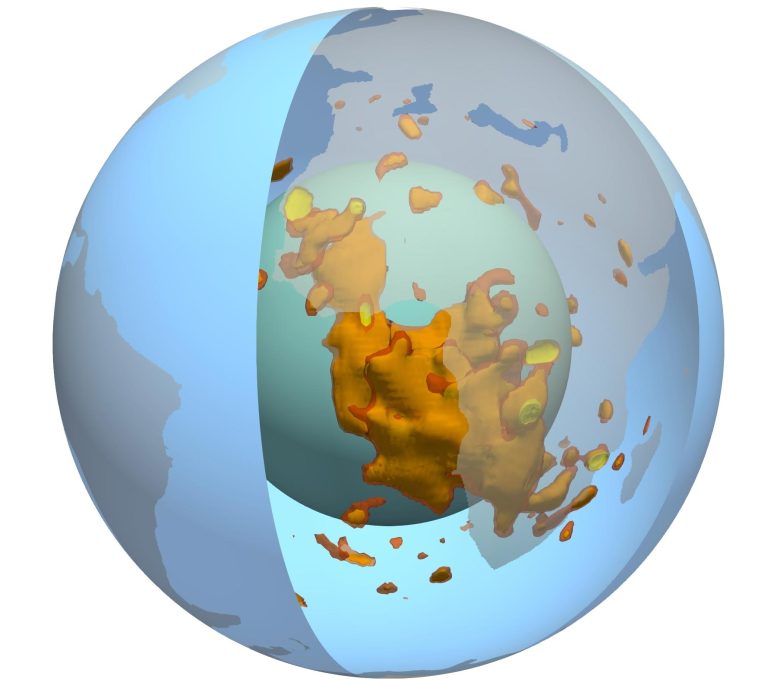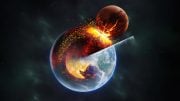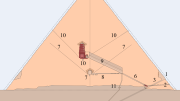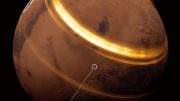
A 3D view of the blob in Earth’s mantle beneath Africa, shown by the red-yellow-orange colors. The cyan color represents the core-mantle boundary, blue signifies the surface, and the transparent gray signifies continents. Credit: Mingming Li/ASU
Earth is layered like an onion, with a thin outer crust, a thick viscous mantle, a fluid outer core, and a solid inner core. Within the mantle, there are two massive blob-like structures, roughly on opposite sides of the planet. The blobs, more formally referred to as Large Low-Shear-Velocity Provinces (LLSVPs), are each the size of a continent and 100 times taller than Mt. Everest. One is under the African continent, while the other is under the Pacific Ocean.
Using instruments that measure seismic waves, scientists know that these two blobs have complicated shapes and structures, but despite their prominent features, little is known about why the blobs exist or what led to their odd shapes.
Arizona State University scientists Qian Yuan and Mingming Li of the School of Earth and Space Exploration set out to learn more about these two blobs using geodynamic modeling and analyses of published seismic studies. Through their research, they were able to determine the maximum heights that the blobs reach and how the volume and density of the blobs, as well as the surrounding viscosity in the mantle, might control their height. Their research was recently published in Nature Geoscience.
The results of their seismic analysis led to a surprising discovery that the blob under the African continent is about 621 miles (1,000 km) higher than the blob under the Pacific Ocean. According to Yuan and Li, the best explanation for the vast height difference between the two is that the blob under the African continent is less dense (and therefore less stable) than the one under the Pacific Ocean.
To conduct their research, Yuan and Li designed and ran hundreds of mantle convection model simulations. They exhaustively tested the effects of key factors that may affect the height of the blobs, including the volume of the blobs and the contrasts of density and viscosity of the blobs compared with their surroundings. They found that to explain the large differences in height between the two blobs, the one under the African continent must be of a lower density than that of the blob under the Pacific Ocean, indicating that the two may have different composition and evolution.
“Our calculations found that the initial volume of the blobs does not affect their height,” lead author Yuan said. “The height of the blobs is mostly controlled by how dense they are and the viscosity of the surrounding mantle.”
“The Africa LLVP may have been rising in recent geological time,” co-author Li added. “This may explain the elevating surface topography and intense volcanism in eastern Africa.”
These findings may fundamentally change the way scientists think about the deep mantle processes and how they can affect the surface of the Earth. The unstable nature of the blob under the African continent, for example, may be related to continental changes in topography, gravity, surface volcanism and plate motion.
“Our combination of the analysis of seismic results and the geodynamic modeling provides new insights on the nature of the Earth’s largest structures in the deep interior and their interaction with the surrounding mantle,” Yuan said. “This work has far-reaching implications for scientists trying to understand the present-day status and the evolution of the deep mantle structure, and the nature of mantle convection.”
Reference: “Instability of the African large low-shear-wave-velocity province due to its low intrinsic density” by Qian Yuan and Mingming Li, 10 March 2022, Nature Geoscience.
DOI: 10.1038/s41561-022-00908-3









Lava? Or something similar perhaps
@Mark Douglas Gordon
just the devil’s farting out the same souls for eternity and again
When two hemispheres collide the size of 5,688 kilometres
1,278 kilometres from centre or 5100 6378 kilometres deep
Solid inner core
2220 kilometres = 3,498 kilometres wide from centre or 2890 5100 kilometres deep
A fluid outer core
2190 kilometres = 5,688 kilometres wide from centre or 700 2890 kilometres deep mantle
A thick viscous mantle
Would you not expect the fluid outer core of 2,200 kilometres wide x 12,000 kilometres long to leak out
Like a blob of welders metal on a metal bar
And if and when it does will it not cool and expand and bulge outwards
And if you say it is older than 300,000,000 years
Would not the pacific one be eroded greater than the terrestrial African one
But more importantly than that
Again as usual with all scientific investigations informing us earthlings of earthy things
No evidence is given of coordinate points of where these superplumes exist
Africa is a large continent does it cover all the underneath of Africa from Tunisia to south Africa very imprecise very lacking in scientific measurement very lacking in metrics if you ask me
And as for the pacific obviously its tiny aint it 800 kilometres x 800 kilometres x 800 kilometres how many blobs can the pacific hold of one of these
1 10 100 1000 and you want us to believe that blob one and blobby two are out there somewhere in the middle of a underground cavern that you me and everybody else has no access too
Well we will believe you when you give coordinated positions and location
Are we at the equator
Are we below at the tropic of Capricorn
And the other one is opposite the which one of the above
or is it none of the above
Where in scientific jargon are we for goodness sake
Playing hide and seek with us wont do any more
what do you take us all to be gombeen people
Maybe it’s a naturally formed fluidic harmonic planetary balancer?
A “harmonic planetary balancer” how I see it as well. However, everything required to sustain life (as we know it) on earth appears much too perfect to be “naturally formed”
@Phil G
What a stupid statement.
@mullach abu
Check out the reference that the article provides for the actual data and research. You seem to have a fundamental misunderstanding on how these articles are produced.
It’s great to see somepeople have an interest about the things around them and sharing with everyone… but its just sad to see somepeople have an interest in stupid…Thanks
I can stand here all day throwing random reasoning at a subject.
The process of partial melting and formation of crust, especially continental crust, leads to a depletion of certain elements (e.g., silicon and aluminum) from the mantle. Undepleted and thus relatively primitive regions still exist, making up about one-third to one-half of the mantle, according to the isotopic models. The distribution of depleted and undepleted regions, however, is uncertain. Although much (perhaps all) of the upper mantle appears to be depleted, it is not known whether depleted rocks also exist in the lower mantle — (https://www.britannica.com/place/Earth/Accretion-of-the-early-Earth) – 13MAR22.
everyone knows it’s the remains of the planetoid that crashed into earth that created the moon.
Fake news, the earth is shaped like a donut (glazed blueberry).
Lemon, poppy seed cake donuts might, seriously, cure cancer!
I drink to have a blob every time they said have.
Wow, not one commenter making snarky, childish comments about Trump.
How refreshing.
Rob, scientists have just discovered another huge blob at Mar a Lago.
Looks like a snowball hit the earth – wonder if they are the remains of a collision.
It’s oil, since that is where oil comes from.
goooooooooooooood
It could just be a part of the moon that’s lonely. Or it could be full of twistorys and spinors or it might be a tectonic anomaly that helped to form the Red Sea. What’s really wonderful about it, ” The Blob Beneath Africa” is that we still have a government that pays for it to be there, one of its warmest features.
“Or” it could be something altogether “OTHER-WORLDLY”!
Bulgarian scientist among 10 top believers in aliens
SFI Santa Fe is quietly into this sort of…
AI Supremacy: Super Intelligence Quantum Computers Documentary.